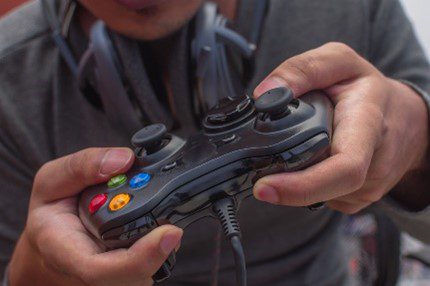
Do YOU have Cybersickness?

‘Cybersickness’ is a catch-all term for symptoms caused by using a computer / screen display,
feels similar to motion sickness, and is caused by sensory conflict in the brain. It is a technology-induced version of motion sickness caused by moving content on screens.

ErgoGirl@ErgoFitConsulting.com
Causes of Cybersickness
- Digital motion sickness, known among medical professionals as visually induced motion sickness, stems from a basic mismatch between sensory inputs (per professor of otolaryngology at Harvard Medical School).
- When you’re focusing on the screen, your brain can suffer from the cognitive dissonance of seeing movement while the rest of your body is relatively still and does not feel the movement. This sensory conflict confuses the brain and can cause symptoms in 50% – 80% of the population and is only beginning to be recognized in the medical community.
- Videos, animated graphics or even just scrolling through your Instagram feed can all contribute to the effect.
Motion sickness severity is measured with the Pensacola Motion Sickness Questionnaire (MSQ), which was conceived by Robert S Kennedy over two decades ago… and now the MSQ is used to measure the severity of Cybersickness
This is not brand new, but it is getting worse with more time on screens and especially video
Military
- The military has long known about these symptoms that even seasoned pilots can feel in flight simulators. And the problem has worsened as simulators incorporated virtual reality and 3D imagery.
- Research study subjects after using Virtual Reality have been found to have trouble with visual focusing, tracking images, hand-eye coordination, and postural stability. This makes operating machinery or even walking a possible hazard. As a result, the military will typically ground a pilot for up to 12 hours after a simulator session due to the aftereffects.
Television & Film & Gaming
- Quick cuts, rapid panning and first-person-view camera angles that now pervade television and film intensify the symptoms.
- Mobile device and gamer forums are full of postings looking for advice on reducing symptoms.

Virtual Reality
- Digital motion sickness is a major challenge for Virtual Reality headset manufacturers.
- Apple added extra accessibility settings to its mobile operating system to allow users to tone down the visual stimuli.
- “The more realistic something is, the more likely you are going to get sick,” said Thomas Stoffregen, professor of kinesiology at the University of Minnesota, who has researched digital motion sickness. “No one got sick playing Pac-Man.”
Video Meetings & Rise of YouTube
- Video is pervasive. Video meetings, video school, and YouTube as the number 1 search engine.
Who
- All of the above can be especially disorientating for people who are already prone to motion sickness, but can happen to anyone and may affect 50% – 80% of people, depending on the fidelity of the digital content and how it is presented.
- Studies show that women are more susceptible than men due to differences in the control of postural balance, as are those with a history of migraines or concussion.
- Anecdotally, researchers say that people with “Type A” personality characteristics — such as perfectionism or ambition — also seem to be more vulnerable, although it is unclear why this might be.

Solutions
Here is a partial list of our 26 solutions:
- When possible, take part in audio meetings instead of video meetings.
- Turn off pop-ups or anything else that is visually distracting.
- Never use the scroll wheel. Instead: Use the ‘Page Down’ and ‘Page Up’ keys, or arrow keys, or click page by page within the scroll bar to the right.
- Never rapidly swipe-scroll on your phone while looking at it. Look away.
- For Video Review of Worksite or Patient Home:
- Issue cameras to workers or patients with corrective gyroscopes to smooth the video content being viewed. Instruct the person taking video to stand still (rather than walk) and slowly pan or zoom in to view an area, as this avoids the oscillations of walking with a camera. Have the person taking video record short video clips. The viewer can work in smaller batches or at a slower speed frame by frame. Photos can be taken as an alternative to video, and then screen-shared so the viewer can ask questions.
Possible Treatment
Ergonomic adjustments and some training may be enough to resolve symptoms. If that is not enough, Vestibular Rehabilitation therapy may help people who suffer from chronic cyber sickness using optokinetic exercises repeatedly to help the brain learn to process these digital visual signals properly. The brain might eventually be able to handle the sensory dissonance described above.
We believe we can help your employees who may be suffering from this new malaise.
Call us at (206) 938-3294
Sources:
- https://well.blogs.nytimes.com/2015/11/14/feeling-woozy-it-may-be-cyber-sickness/
- https://www.besthealthmag.ca/best-you/wellness/cyber-sickness/
- https://balanceanddizziness.org/disorders/vestibular-disorders/motion-and-cyber-sickness/#treatment2
- https://www.psychologytoday.com/us/blog/healthy-eating-healthy-relating/202008/cybersickness-is-real
ErgoFitConsulting.com 206-938-3294
